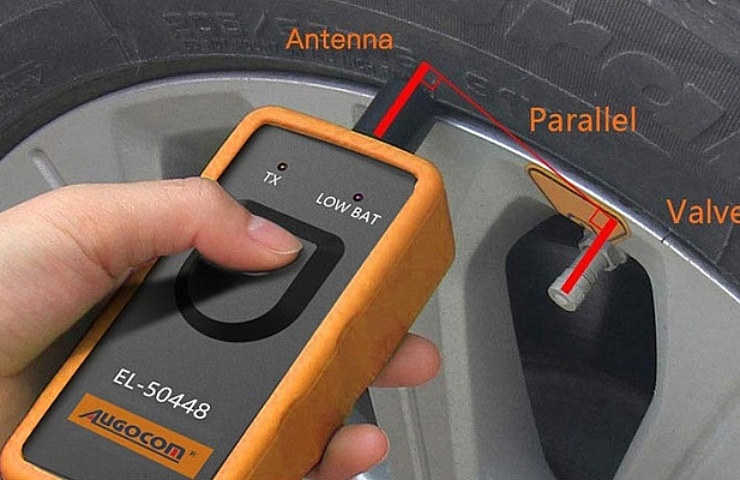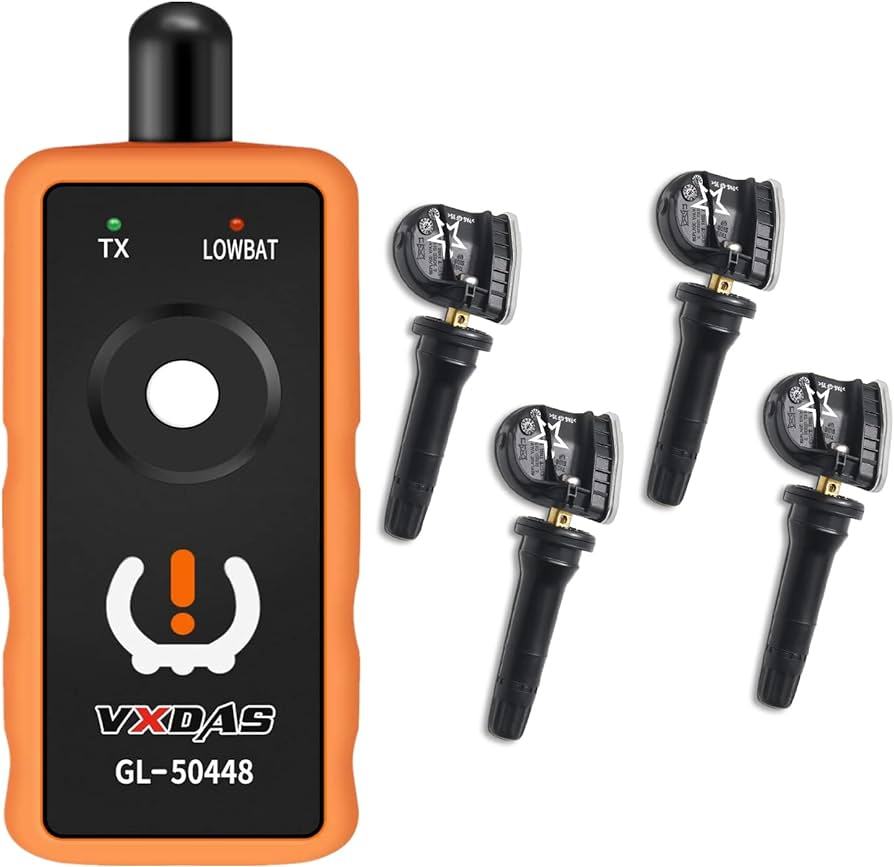To reprogram a tire pressure sensor, use a scan tool or follow your vehicle’s specific reprogramming procedure. Refer to the owner’s manual for detailed instructions.
Reprogramming tire pressure sensors is crucial for maintaining optimal vehicle performance and safety. Tire pressure sensors monitor the air pressure in your tires and alert you to any significant changes. This ensures that your tires are properly inflated, which can improve fuel efficiency, extend tire life, and improve overall driving safety.
Regularly reprogramming these sensors is especially important after tire rotations, replacements, or sensor replacements. Understanding the reprogramming process can save you time and prevent potential issues. Always consult your vehicle’s owner’s manual for specific steps and use a reliable scan tool for accurate results.

Introduction To Tire Pressure Sensors
Tire pressure sensors are vital for modern vehicles. They help monitor tire pressure. These sensors ensure your tires are at the correct pressure. This improves safety and extends tire life. Understanding these sensors is essential for all car owners.
The Role Of Tire Pressure Monitoring
Tire Pressure Monitoring Systems (TPMS) alert you to low tire pressure. They use sensors in each tire. These sensors send data to your car’s computer. The computer then displays warnings on your dashboard. This system helps prevent tire blowouts. It also increases fuel efficiency and ensures optimal vehicle performance.
Benefits Of Proper Tire Pressure
Maintaining proper tire pressure offers numerous benefits. Here are some key advantages:
- Improved Safety: Correct tire pressure reduces the risk of accidents.
- Extended Tire Life: Proper pressure prevents uneven tire wear.
- Better Fuel Efficiency: Well-inflated tires reduce fuel consumption.
- Improved Vehicle Performance: Proper pressure ensures better handling and stability.
By keeping your tires properly inflated, you save money and stay safe on the road. Regularly check your tire pressure and ensure your TPMS is functioning correctly.

Common Signs Of A Malfunctioning Sensor
A malfunctioning tire pressure sensor can lead to various problems. Knowing the signs can help you act quickly.
Warning Lights And Alerts
One of the most common signs is the Tire Pressure Monitoring System (TPMS) warning light. This light appears on the dashboard. It indicates that there is an issue with your tire pressure.
Another alert might come as a flashing TPMS light. A flashing light usually means there is a problem with the sensor itself. It is important to address this issue promptly to avoid tire damage.
Inaccurate Pressure Readings
Inaccurate pressure readings are another sign. You might notice that the sensor displays a constant low or high pressure. This can be confusing and misleading.
Sometimes, the sensor may show different readings for the same tire. This inconsistency can cause you to overinflate or underinflate your tires.
Inaccurate readings can lead to uneven tire wear, affecting your vehicle’s performance. Always ensure your sensor is functioning correctly for accurate readings.
| Sign | Description |
|---|---|
| Warning Lights | TPMS light on the dashboard indicating tire pressure issues. |
| Flashing TPMS Light | Indicates a problem with the sensor itself. |
| Inaccurate Readings | Displays constant low or high pressure, misleading readings. |
| Inconsistent Readings | Shows different readings for the same tire. |
Recognizing these signs early can save you from bigger issues. Keep your sensor in good shape for a smoother ride.
Tools And Materials Needed
Reprogramming your tire pressure sensor is crucial for safety. It ensures accurate tire pressure readings. This section covers the tools and materials you need.
Essential Equipment For Reprogramming
You need specific tools for reprogramming your tire pressure sensor. Here is a list of essential equipment:
- TPMS Relearn Tool – This device is necessary for reprogramming.
- Air Pressure Gauge – Ensures accurate tire pressure readings.
- OBDII Scanner – Helps diagnose and clear error codes.
- Tire Inflator – Used to adjust tire pressure as needed.
Safety Precautions
Follow these safety precautions to ensure a safe reprogramming process:
- Park on a Level Surface – Avoid sloped areas to prevent accidents.
- Turn Off the Engine – Ensure the vehicle is off before starting.
- Wear Safety Gear – Use gloves and safety glasses for protection.
- Check the Manual – Refer to your vehicle’s manual for specific instructions.
Step-by-step Reprogramming Procedure
Reprogramming your tire pressure sensor can seem daunting. But with the right steps, it becomes simple. Here’s a comprehensive guide to help you through the process.
Initializing The Reprogramming Sequence
First, ensure your vehicle is in park and turned off. Then, locate the reset button. This button is usually near the steering column.
Press and hold the reset button. Turn your key to the “On” position while holding the button. Do not start the engine.
A few seconds later, the tire pressure warning light should blink three times. This indicates that the reprogramming sequence has started.
Release the reset button. Wait for about 20 minutes for the sensor to reset.
Completing The Sensor Configuration
After waiting, check each tire’s pressure. Ensure they are inflated to the recommended level. You can find this information in your vehicle’s manual.
Drive your vehicle at a speed above 30 mph for at least 10 minutes. This helps the system relearn the new sensor positions.
If the warning light turns off, the reprogramming is successful. If it stays on, repeat the process or consult a professional.
Here is a quick summary in a table:
| Step | Action |
|---|---|
| 1 | Ensure vehicle is in park and turned off |
| 2 | Locate and hold the reset button |
| 3 | Turn key to “On” position |
| 4 | Wait for the tire pressure warning light to blink |
| 5 | Release the reset button |
| 6 | Wait for 20 minutes |
| 7 | Check and inflate tires |
| 8 | Drive above 30 mph for 10 minutes |
By following these steps, you can ensure your tire pressure sensors are properly reprogrammed. This will help maintain optimal tire performance and safety.
Troubleshooting Reprogramming Issues
Reprogramming tire pressure sensors can sometimes be tricky. You might face errors during the process. This guide will help you troubleshoot common issues and know when to seek professional help.
Dealing With Common Errors
Common errors can occur during the reprogramming of tire pressure sensors. It is essential to recognize and address them promptly. Here are some of the most frequent issues and their solutions:
- Incorrect Sensor ID: Ensure the sensor ID matches your vehicle’s system.
- Low Battery: Check if the sensor’s battery is low. Replace if necessary.
- Signal Interference: Avoid areas with high electronic interference during reprogramming.
When To Seek Professional Help
Sometimes, despite best efforts, you may not resolve the issues by yourself. Knowing when to seek professional help is crucial. Here are some scenarios:
- Persistent Errors: If errors persist, consult a professional technician.
- Complex Systems: Vehicles with advanced systems may need expert handling.
- Tool Limitations: If your reprogramming tool is outdated or incompatible.
By understanding these common issues and knowing when to seek help, you can ensure your tire pressure sensors function correctly.

Maintaining Your Tire Pressure Sensors
Keeping your tire pressure sensors in good shape is vital. They ensure your car’s tires are properly inflated. This helps with safety and fuel efficiency. Here’s how to keep them working well.
Regular Check-ups And Diagnostics
Regular check-ups are important for tire pressure sensors. Inspect them every few months. Look for any signs of wear or damage.
Use a diagnostic tool to check sensor performance. This tool can identify issues early. Replace any faulty sensors immediately.
Also, keep an eye on your dashboard. Your car might alert you if there’s a sensor problem. Address these alerts quickly to avoid bigger issues.
Long-term Sensor Care
Long-term care ensures your sensors last longer. Clean the sensors regularly. Dirt and debris can affect their performance.
Maintain correct tire pressure. Overinflated or underinflated tires can damage sensors. Use a reliable tire gauge to check pressure.
Protect sensors during tire changes. Inform your mechanic about the sensors. They need to handle them carefully.
Here is a simple table to help you with sensor care:
| Task | Frequency |
|---|---|
| Visual Inspection | Every 3 months |
| Diagnostic Check | Every 6 months |
| Cleaning | Every 3 months |
| Pressure Check | Monthly |
By following these steps, your tire pressure sensors will stay in good condition. This ensures a safer and more efficient driving experience.
Frequently Asked Questions
Can I Reset My Tire Sensors Myself?
Yes, you can reset your tire sensors yourself. Refer to your vehicle’s manual for specific instructions.
Does A Tire Pressure Sensor Have To Be Programmed?
Yes, a tire pressure sensor often needs programming. This ensures it communicates correctly with your vehicle’s system.
Can You Relearn Tpms Sensors Without A Tool?
Relearning TPMS sensors without a tool is possible for some vehicles. Check your vehicle’s manual for specific instructions.
How Do I Resync My Tire Pressure Sensor?
To resync your tire pressure sensor, turn your vehicle on and off. Then, drive for about 20 minutes. Ensure tire pressures are correct. If needed, consult your vehicle’s manual for specific instructions.
What Is A Tire Pressure Sensor?
A tire pressure sensor monitors and reports tire pressure to ensure safety and efficiency.
Conclusion
Reprogramming your tire pressure sensor ensures safety and efficiency. Follow the steps carefully for accurate results. Regular maintenance can prevent potential issues. Keep your vehicle’s sensors updated for optimal performance. A little effort can save you from bigger problems down the road.
Stay proactive and enjoy a smoother driving experience.





















